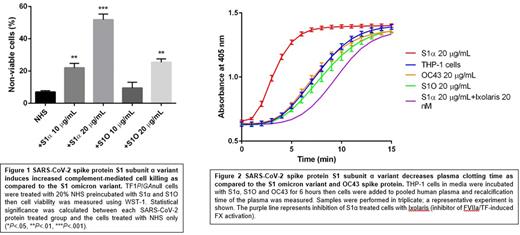Abstract
Introduction: Infection caused by the SARS-CoV-2 virus is marked by both a localized and systemic inflammatory response and coagulopathy leading to end organ damage and mortality. Notwithstanding individual patient risk factors and more widespread immunity, mutations in SARS-CoV-2, commonly involving the spike protein, have yielded fluctuations in disease manifestations and severity. Clinically, the first alpha (α) variant was marked by elevated incidence of thromboembolism, intensive care unit (ICU) admissions and mortality, whereas the omicron BA.1 (O) variant has been associated with lower rates of hospitalization, ICU admissions, and need for mechanical ventilation (Fan et. al. Signal Transduction and Targeted Therapy 2022). We previously showed that the S1 subunit of the α spike protein containing the receptor binding domain critical for viral host cell entry leads to dysregulation of the alternative pathway of complement through binding to heparan sulfate and competing for binding of factor H. Further, complement amplification is associated with disease severity in hospitalized patients. Using ex vivo assays of complement and coagulation, we sought to characterize the effects of the S1 subunit from the α and O SARS-CoV-2 spike protein variants as compared to the OC43 spike protein, a common human coronavirus associated with mild upper respiratory tract illness.
Methods: The SARS-CoV-2 α variant S1 subunit (S1α) and Omicron variant BA.1.1.529 S1 (S1O) recombinant proteins were obtained from Raybiotech and human coronavirus OC43 recombinant spike protein (OC43 S) from Sino Biological. Complement assays including the modified Ham (mHam) test and flow cytometry for cell surface deposition of complement C5b-9 were performed as previously described using the spike proteins added to normal human serum (NHS) to activate complement on TF1PIGAnull cells (Yu et. al. Blood 2020). For coagulation assays, the spike proteins were incubated with THP-1 cells, a monocytic cell line, at 37°C in RPMI with 10% fetal bovine serum. Tissue factor (TF) relative mRNA expression was quantified using RT-PCR at various time points and normalized to GADPH expression. After 6 hours incubation, cells (150,000-200,000 cells/well) were washed with PBS then resuspended in pooled human plasma. Clotting activity was measured by the recalcification time of the plasma using a BioTeK ELx808 plate reader at 405 nm. Ixolaris 20 nM (Francischetti et. al. Blood 2002), a tick salivary protein that inhibits FVIIa/TF-induced FX activation, was incubated with cells and plasma at 37°C for 10 minutes prior to plasma recalcification in select samples. Experiments were performed in triplicate. Data is presented as mean ± standard error. The Student t test was used to assess the difference between unpaired groups with a value of P<.05 considered statistically significant.
Results: In the mHam test, addition of S1α 20 µg/mL to NHS led to significantly more complement-mediated cell killing after 2 hours as compared to S1O (P<.05) (Figure 1). A dose dependent effect was observed for S1α and S1O. S1α also led to increased deposition of C5b-9 on the TF1PIGAnull cell surface as compared to S1O (44.2% vs. 16.5% at 20 µg/mL and 35.8% vs. 15.3% at 10 µg/mL). OC43 did not lead to a significant increase in cell killing in the mHam or C5b-9 deposition on the cell surface as previously published (Yu et. al. Blood 2020). In the plasma recalcification assay, incubation of THP-1 cells with S1α at 20 µg/mL led to decreased time to initiation and peak clot formation as compared to S1O and OC43 S, which were comparable to the clotting observed with the cells alone (Figure 2). Addition of Ixolaris 20 nM prolonged time to clot formation in the S1α treated cells, suggesting that the faster rate of plasma clotting is at least in part TF dependent. Further, TF mRNA expression was increased more than threefold at 1 hour in the S1α (20 µg/mL) treated cells as compared to untreated cells. The maximum increase in TF expression for the S1O (20 µg/mL) treated cells was approximately 1.5x at 2 hours.
Conclusions: TF activity and complement amplification induced by the coronavirus spike proteins in vitro correlates with their respective clinical phenotype and disease severity. This suggests that the effects of SARS-CoV-2 on the complement and coagulation systems derive from the spike protein, and these assays may be useful in predicting pathogenicity of spike protein variants.
Disclosures
Gerber:Pfizer (spouse): Current Employment, Current equity holder in publicly-traded company, Divested equity in a private or publicly-traded company in the past 24 months. Brodsky:Alexion: Honoraria.
Author notes
Asterisk with author names denotes non-ASH members.


This feature is available to Subscribers Only
Sign In or Create an Account Close Modal